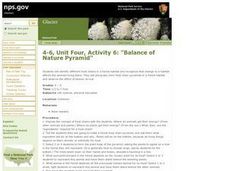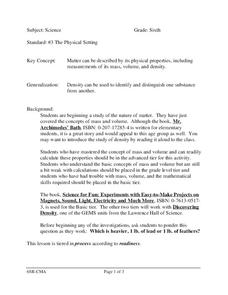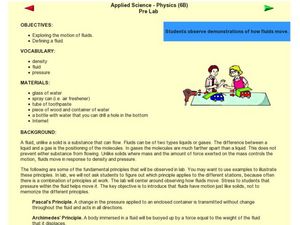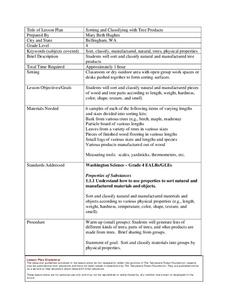Curated OER
Name that Natural Resource
Young scholars discuss natural resources. In this science lesson, students understand that physical properties can be used to identify minerals and complete the chart each day working alone or in a small group.
Curated OER
Science - Kinds of Materials
In this science worksheet, learners answer 10 true or false questions about kinds of materials and their characteristics. They complete a chart by naming 4 different materials, naming an object made from that material, and indicate one...
Curated OER
Balance of Nature Pyramid
Students study the concept of food chains and create a physical forest food chain pyramid. In this balance of nature pyramid lesson, students identify the ingredients needed on each level of the pyramid then make connections...
Curated OER
Naturally Magnetic Elements
Pupils explore naturally magnetic elements. In this magnets lesson, students examine the periodic table of elements. Pupils discover the parts of an atom and determine which three elements are magnetic.
Curated OER
Nature and Nurture
Students look into the role both nature and nurture play in determining an individual's traits. They examine how genes and the environment affect personality
Curated OER
Nature And Nurture
Students develop an understanding of the role both nature and nurture play in determining an individual's traits. Using a website, students answer questions about nature and nurture in order to solve the riddle, What do you call a smart...
Curated OER
Physical properties of matter
Sixth graders find the physical properties of matter. In this matter lesson, 6th graders measure mass, volume, and density. Students are broken into 3 tiers with 3 different activities based on their understanding of mass and volume.
Curated OER
Applied Science Physics Pre Lab
Students explore physics. In this magnetism lesson plan, students attempt to make a magnet out of a iron rod. They observe the teacher complete the procedure first and then try it themselves.
Curated OER
In your Science! - Merging Art and Science
Ninth graders reflect on what they have learned throughout the unit. In this Science lesson, 9th graders demonstrate how working together can produce an informative useful project.
Curated OER
Elements for Disaster Reporting
Students identify the elements of natural disasters and gain an understanding on how the media influences people's responses to disasters. In this natural disaster lesson plan, students study the impact of natural disasters, and the...
Curated OER
Magnets
Students demonstrate the process of science by posing questions and investigating phenomena through language, methods and instruments of science as they experiment at four teacher-created stations to explain the fundamentals of magnetism.
Curated OER
Simple Harmonic Motion with Dr. DAQ
Students study the work and accomplishment of Galileo. In this physics lesson, students calculate the period of a pendulum's using a mathematical equation. They explain the different factors affecting its period.
Curated OER
Sorting and Classifying with Tree Products
Fourth graders sort and classify wood. In this sorting tree products lesson, 4th graders sort and classify tree parts and pieces of wood, both natural and manufactured according to their properties.
Curated OER
ChromaCool!
Fifth graders watch a video about physical and chemical changes. In groups, they participate in a variety of activities involving color. They write their observations in a journal. To end the lesson, they use a checklist to classify...
Curated OER
Fire Triangle in the Forest
Students investigate the physical properties of fire by creating storyboards. In this elements lesson, students view a video clip of forest fires and identify the cause. Students create large storyboards defining the three...
Curated OER
Here Today, Gone Tomorrow
Students study the difference between chemical and physical weathering. They explore the effects of climate on the weathering process.
PHET
Earth’s Magnetic Field from Space
Feel the pull of science! The final installment of this 18-part series is an application of everything learned in the previous high school lessons. Scholars are given a magnetic field map and must propose an arrangement of magnets that...
Curated OER
Genetics
Comprehend that many human characteristics-all physical traits and possibly many personality traits-are determined by our genetic makeup. These activities demonstate that all physical traits are genetically determined, some evidence...
Curated OER
Human Evolution: Biology, Bones
Learners will love a weeks worth of bone study. They use bones and characteristics of bones to explore the evolution of hominoids. Bones are compared, categorized, and considered. A great way to bring physical anthropology and material...
University of Colorado
Terra Bagga
One way to identify possible volcanic activity on other planets is by testing the planet for magnetism. A science lesson begins with pupils constructing their own planet from a dead battery, magnets, paper, and tape before labeling...
Curated OER
Resources and Economic Development
Identify natural resources in the world and how they translate into economic development. In this global economy instructional activity, your class will utilize the Internet to view an Oregon Time Web which they research to examine the...
NASA
Cosmic Microwave Background
Begin your next class with a BANG! Pupils discuss the formation of our universe and its expansion before proceeding with an activity designed to demonstrate what most likely occurred billions of years ago. They conclude with a discussion...
Virginia Department of Education
The Law of Conservation of Matter
The Law of Conservation of Matter can be complex for young scientists to fully grasp. Use this experiment to help simplify the process as pupils perform two experiments to determine mass: one that melts a substance and the other that...
Curated OER
Rocks and Minerals
Review the difference between rocks and minerals using this resource. Learners identify and investigate the physical properties of these objects. They create a Venn diagram to compare and contrast types of rocks. This is a motivating way...

























